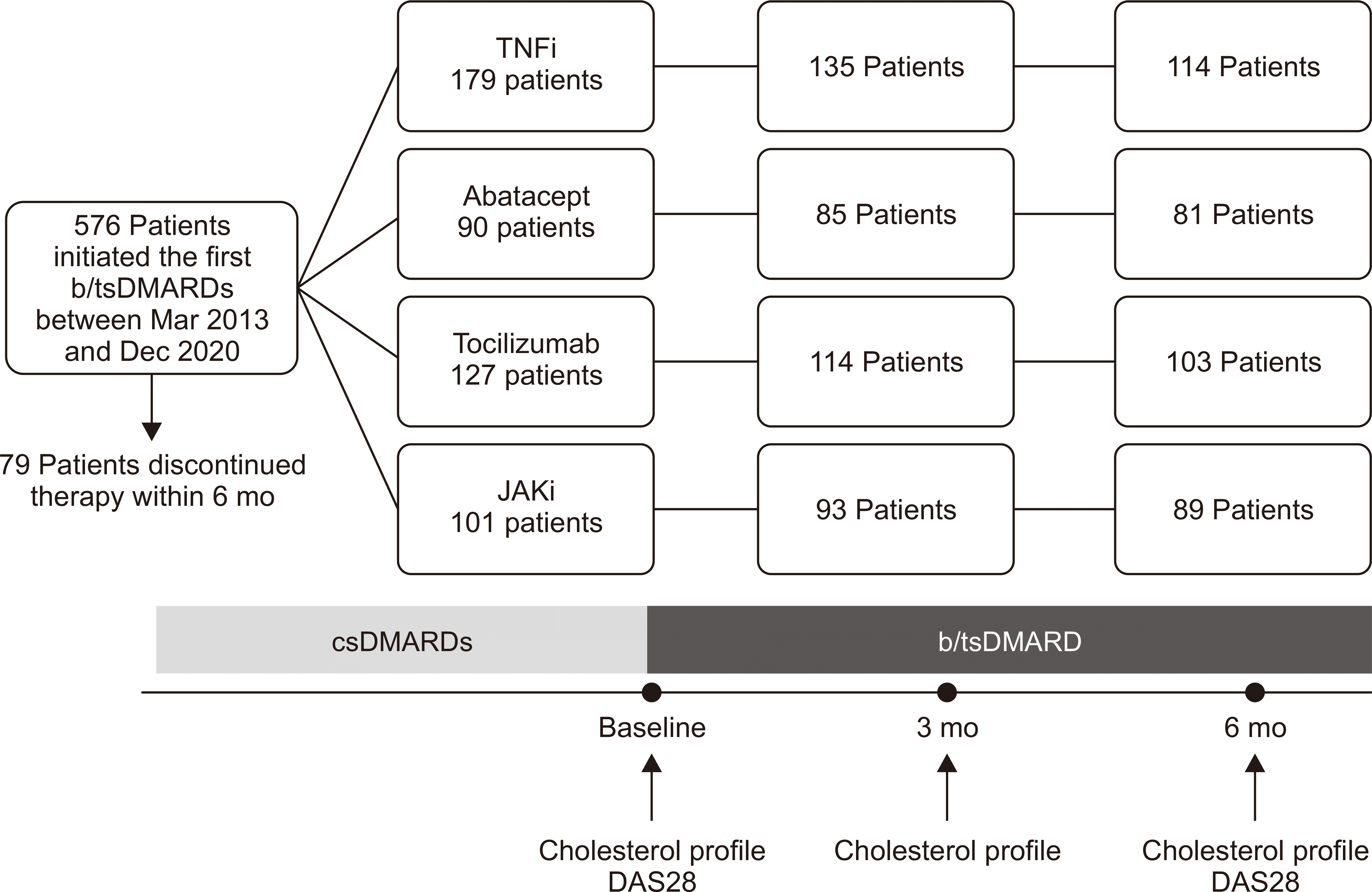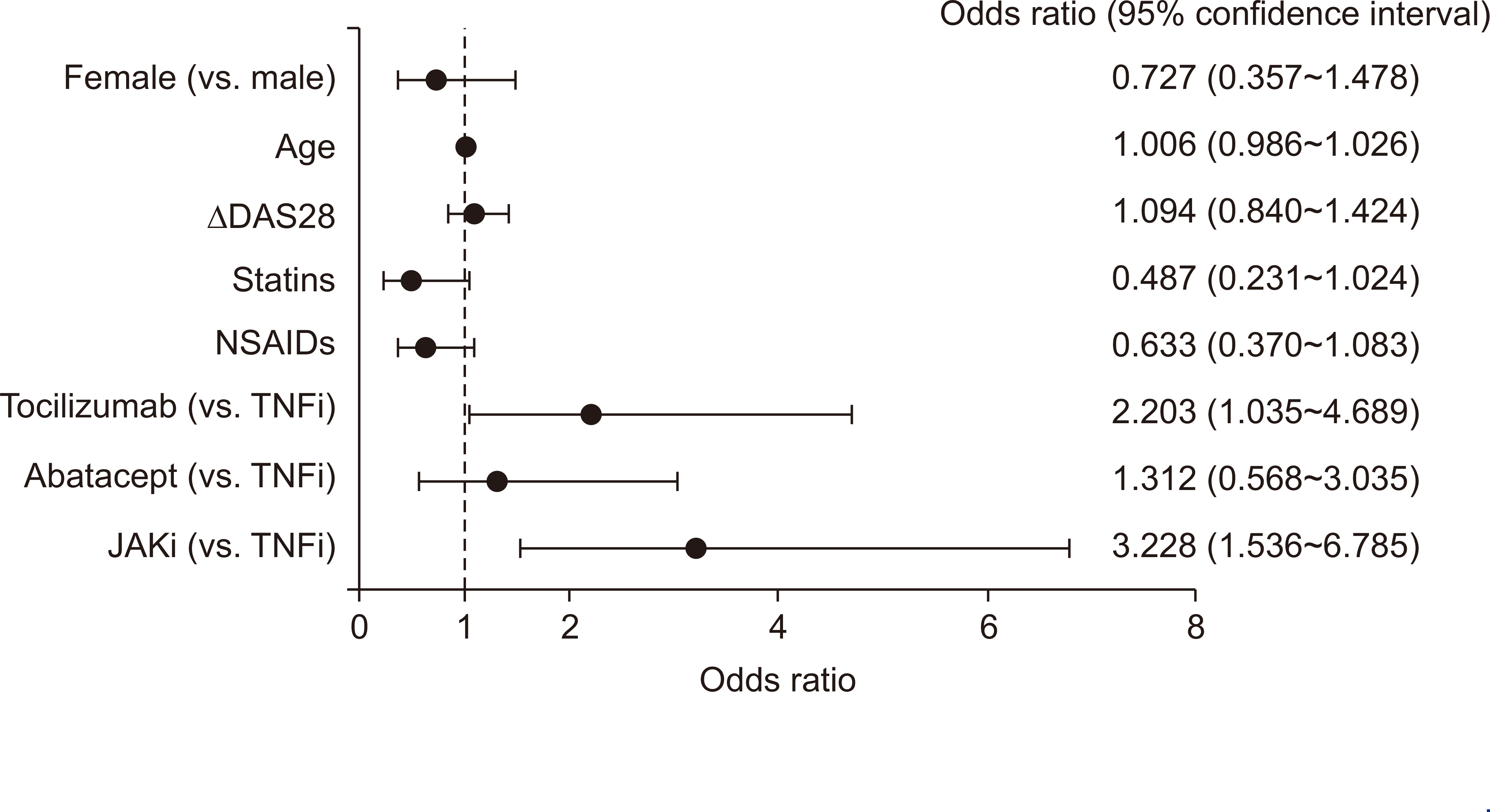1. Dadoun S, Zeboulon-Ktorza N, Combescure C, Elhai M, Rozenberg S, Gossec L, et al. 2013; Mortality in rheumatoid arthritis over the last fifty years: systematic review and meta-analysis. Joint Bone Spine. 80:29–33. DOI:
10.1016/j.jbspin.2012.02.005. PMID:
22459416.

2. Widdifield J, Paterson JM, Huang A, Bernatsky S. 2018; Causes of death in rheumatoid arthritis: how do they compare to the general population? Arthritis Care Res (Hoboken). 70:1748–55. DOI:
10.1002/acr.23548. PMID:
29512334.

3. Nurmohamed MT, Heslinga M, Kitas GD. 2015; Cardiovascular comorbidity in rheumatic diseases. Nat Rev Rheumatol. 11:693–704. DOI:
10.1038/nrrheum.2015.112. PMID:
26282082.

4. Schwartz DM, Kanno Y, Villarino A, Ward M, Gadina M, O'Shea JJ. 2017; JAK inhibition as a therapeutic strategy for immune and inflammatory diseases. Nat Rev Drug Discov. 16:843–62. Erratum in: Nat Rev Drug Discov 2017;17:78. DOI:
10.1038/nrd.2017.201. PMID:
29104284. PMCID:
PMC6168198.

5. Ytterberg SR, Bhatt DL, Mikuls TR, Koch GG, Fleischmann R, Rivas JL, et al. 2022; Cardiovascular and cancer risk with tofacitinib in rheumatoid arthritis. N Engl J Med. 386:316–26. DOI:
10.1056/NEJMoa2109927. PMID:
35081280.

6. Robertson J, Peters MJ, McInnes IB, Sattar N. 2013; Changes in lipid levels with inflammation and therapy in RA: a maturing paradigm. Nat Rev Rheumatol. 9:513–23. DOI:
10.1038/nrrheum.2013.91. PMID:
23774906.

7. Kremer JM, Genovese MC, Keystone E, Taylor PC, Zuckerman SH, Ruotolo G, et al. 2017; Effects of baricitinib on lipid, apolipoprotein, and lipoprotein particle profiles in a phase IIb study of patients with active rheumatoid arthritis. Arthritis Rheumatol. 69:943–52. DOI:
10.1002/art.40036. PMID:
28029752.

8. Lee EB, Fleischmann R, Hall S, Wilkinson B, Bradley JD, Gruben D, et al. 2014; Tofacitinib versus methotrexate in rheumatoid arthritis. N Engl J Med. 370:2377–86. DOI:
10.1056/NEJMoa1310476. PMID:
24941177.

9. Pollono EN, Lopez-Olivo MA, Lopez JA, Suarez-Almazor ME. 2010; A systematic review of the effect of TNF-alpha antagonists on lipid profiles in patients with rheumatoid arthritis. Clin Rheumatol. 29:947–55. DOI:
10.1007/s10067-010-1405-7. PMID:
20383550.

10. van Vollenhoven RF, Fleischmann R, Cohen S, Lee EB, García Meijide JA, Wagner S, et al. 2012; Tofacitinib or adalimumab versus placebo in rheumatoid arthritis. N Engl J Med. 367:508–19. Erratum in: N Engl J Med 2013;369:293. DOI:
10.1056/NEJMoa1112072. PMID:
22873531.

11. Ference BA, Graham I, Tokgozoglu L, Catapano AL. 2018; Impact of lipids on cardiovascular health: JACC Health Promotion Series. J Am Coll Cardiol. 72:1141–56. DOI:
10.1016/j.jacc.2018.06.046. PMID:
30165986.
12. Grundy SM, Stone NJ, Bailey AL, Beam C, Birtcher KK, Blumenthal RS, et al. 2019; 2018 AHA/ACC/AACVPR/AAPA/ABC/ACPM/ADA/AGS/APhA/ASPC/NLA/PCNA guideline on the management of blood cholesterol: a report of the American College of Cardiology/American Heart Association Task Force on Clinical Practice Guidelines. Circulation. 139:e1082–143. Erratum in: Circulation 2019;139:e1182-6. DOI:
10.1161/CIR.0000000000000624. PMID:
30586774. PMCID:
PMC7403606.
13. Langlois MR, Sniderman AD. 2020; Non-HDL cholesterol or apoB: which to prefer as a target for the prevention of atherosclerotic cardiovascular disease? Curr Cardiol Rep. 22:67. DOI:
10.1007/s11886-020-01323-z. PMID:
32562186.

14. Colantonio LD, Bittner V, Reynolds K, Levitan EB, Rosenson RS, Banach M, et al. 2016; Association of serum lipids and coronary heart disease in contemporary observational studies. Circulation. 133:256–64. DOI:
10.1161/CIRCULATIONAHA.115.011646. PMID:
26659948. PMCID:
PMC4718875.

15. Brunner FJ, Waldeyer C, Ojeda F, Salomaa V, Kee F, Sans S, et al. 2019; Application of non-HDL cholesterol for population-based cardiovascular risk stratification: results from the Multinational Cardiovascular Risk Consortium. Lancet. 394:2173–83. Erratum in: Lancet 2019;394:2154. Erratum in: Lancet 2020;395:32. DOI:
10.1016/S0140-6736(19)32519-X. PMID:
31810609. PMCID:
PMC6913519.

16. Nordestgaard BG, Langsted A, Mora S, Kolovou G, Baum H, Bruckert E, et al. 2016; Fasting is not routinely required for determination of a lipid profile: clinical and laboratory implications including flagging at desirable concentration cut-points-a joint consensus statement from the European Atherosclerosis Society and European Federation of Clinical Chemistry and Laboratory Medicine. Eur Heart J. 37:1944–58. DOI:
10.1093/eurheartj/ehw152. PMID:
27122601. PMCID:
PMC4929379.

17. Aletaha D, Neogi T, Silman AJ, Funovits J, Felson DT, Bingham CO 3rd, et al. 2010; 2010 Rheumatoid arthritis classification criteria: an American College of Rheumatology/European League Against Rheumatism collaborative initiative. Arthritis Rheum. 62:2569–81. DOI:
10.1002/art.27584. PMID:
20872595.

18. van Gestel AM, Prevoo ML, van 't Hof MA, van Rijswijk MH, van de Putte LB, van Riel PL. 1996; Development and validation of the European League Against Rheumatism response criteria for rheumatoid arthritis. Comparison with the preliminary American College of Rheumatology and the World Health Organization/International League Against Rheumatism Criteria. Arthritis Rheum. 39:34–40. DOI:
10.1002/art.1780390105. PMID:
8546736.

19. Rhee EJ, Kim HC, Kim JH, Lee EY, Kim BJ, Kim EM, et al. 2019; 2018 Guidelines for the management of dyslipidemia in Korea. J Lipid Atheroscler. 8:78–131. DOI:
10.12997/jla.2019.8.2.78. PMID:
32821702. PMCID:
PMC7379116.

20. Welsh C, Celis-Morales CA, Brown R, Mackay DF, Lewsey J, Mark PB, et al. 2019; Comparison of conventional lipoprotein tests and apolipoproteins in the prediction of cardiovascular disease. Circulation. 140:542–52. DOI:
10.1161/CIRCULATIONAHA.119.041149. PMID:
31216866. PMCID:
PMC6693929.

21. Gabay C, McInnes IB, Kavanaugh A, Tuckwell K, Klearman M, Pulley J, et al. 2016; Comparison of lipid and lipid-associated cardiovascular risk marker changes after treatment with tocilizumab or adalimumab in patients with rheumatoid arthritis. Ann Rheum Dis. 75:1806–12. DOI:
10.1136/annrheumdis-2015-207872. PMID:
26613768. PMCID:
PMC5036214.

22. Lee J, Lee S, Zhang H, Hill MA, Zhang C, Park Y. 2017; Interaction of IL-6 and TNF-α contributes to endothelial dysfunction in type 2 diabetic mouse hearts. PLoS One. 12:e0187189. DOI:
10.1371/journal.pone.0187189. PMID:
29095915. PMCID:
PMC5667841.

23. Hashizume M, Mihara M. 2012; Atherogenic effects of TNF-α and IL-6 via up-regulation of scavenger receptors. Cytokine. 58:424–30. DOI:
10.1016/j.cyto.2012.02.010. PMID:
22436638.

25. Hunter CA, Jones SA. 2015; IL-6 as a keystone cytokine in health and disease. Nat Immunol. 16:448–57. Erratum in: Nat Immunol 2017; 18:1271. DOI:
10.1038/ni.3153. PMID:
25898198.

26. Hashizume M, Mihara M. 2012; Blockade of IL-6 and TNF-α inhibited oxLDL-induced production of MCP-1 via scavenger receptor induction. Eur J Pharmacol. 689:249–54. DOI:
10.1016/j.ejphar.2012.05.035. PMID:
22683409.

27. Bianconi V, Sahebkar A, Atkin SL, Pirro M. 2018; The regulation and importance of monocyte chemoattractant protein-1. Curr Opin Hematol. 25:44–51. DOI:
10.1097/MOH.0000000000000389. PMID:
28914666.

29. Srivastava S, Rasool M. 2022; Underpinning IL-6 biology and emphasizing selective JAK blockade as the potential alternate therapeutic intervention for rheumatoid arthritis. Life Sci. 298:120516. DOI:
10.1016/j.lfs.2022.120516. PMID:
35367240.

30. Cernkovich ER, Deng J, Bond MC, Combs TP, Harp JB. 2008; Adipose-specific disruption of signal transducer and activator of transcription 3 increases body weight and adiposity. Endocrinology. 149:1581–90. DOI:
10.1210/en.2007-1148. PMID:
18096662. PMCID:
PMC2276706.

31. Verghese PB, Arrese EL, Soulages JL. 2007; Stimulation of lipolysis enhances the rate of cholesterol efflux to HDL in adipocytes. Mol Cell Biochem. 302:241–8. DOI:
10.1007/s11010-007-9447-0. PMID:
17390217.

32. Charles-Schoeman C, Fleischmann R, Davignon J, Schwartz H, Turner SM, Beysen C, et al. 2015; Potential mechanisms leading to the abnormal lipid profile in patients with rheumatoid arthritis versus healthy volunteers and reversal by tofacitinib. Arthritis Rheumatol. 67:616–25. DOI:
10.1002/art.38974. PMID:
25470338. PMCID:
PMC5024065.

33. Charles-Schoeman C, Gugiu GB, Ge H, Shahbazian A, Lee YY, Wang X, et al. 2018; Remodeling of the HDL proteome with treatment response to abatacept or adalimumab in the AMPLE trial of patients with rheumatoid arthritis. Atherosclerosis. 275:107–14. DOI:
10.1016/j.atherosclerosis.2018.04.003. PMID:
29886354. PMCID:
PMC6113060.

34. Ozen G, Pedro S, Michaud K. 2021; The risk of cardiovascular events associated with disease-modifying antirheumatic drugs in rheumatoid arthritis. J Rheumatol. 48:648–55. DOI:
10.3899/jrheum.200265. PMID:
32801134.

35. Myasoedova E, Crowson CS, Kremers HM, Roger VL, Fitz-Gibbon PD, Therneau TM, et al. 2011; Lipid paradox in rheumatoid arthritis: the impact of serum lipid measures and systemic inflammation on the risk of cardiovascular disease. Ann Rheum Dis. 70:482–7. DOI:
10.1136/ard.2010.135871. PMID:
21216812. PMCID:
PMC3058921.

36. Stary HC, Chandler AB, Glagov S, Guyton JR, Insull W Jr, Rosenfeld ME, et al. 1994; A definition of initial, fatty streak, and intermediate lesions of atherosclerosis. A report from the Committee on Vascular Lesions of the Council on Arteriosclerosis, American Heart Association. Circulation. 89:2462–78. DOI:
10.1161/01.CIR.89.5.2462. PMID:
8181179.

37. Park JB, Kim DH, Lee H, Hwang IC, Yoon YE, Park HE, et al. 2020; Mildly abnormal lipid levels, but not high lipid variability, are associated with increased risk of myocardial infarction and stroke in "statin-naive" young population a nationwide cohort study. Circ Res. 126:824–35. DOI:
10.1161/CIRCRESAHA.119.315705. PMID:
31978313.

38. Bisoendial RJ, Stroes ES, Kastelein JJ, Tak PP. 2010; Targeting cardiovascular risk in rheumatoid arthritis: a dual role for statins. Nat Rev Rheumatol. 6:157–64. DOI:
10.1038/nrrheum.2009.277. PMID:
20142814.

39. Min HK, Kim HR, Lee SH, Shin K, Kim HA, Park SH, et al. 2021; Four-year follow-up of atherogenicity in rheumatoid arthritis patients: from the nationwide Korean College of Rheumatology Biologics Registry. Clin Rheumatol. 40:3105–13. DOI:
10.1007/s10067-021-05613-x. PMID:
33576925.







 PDF
PDF Citation
Citation Print
Print



 XML Download
XML Download